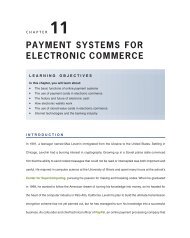ELECTRONIC COMMERCE SOFTWARE
ELECTRONIC COMMERCE SOFTWARE
ELECTRONIC COMMERCE SOFTWARE
Create successful ePaper yourself
Turn your PDF publications into a flip-book with our unique Google optimized e-Paper software.
426<br />
Chapter 9<br />
Customer Relationship Management Software<br />
You learned about the philosophy and techniques of customer relationship management<br />
(CRM) in Chapter 4. The goal of CRM is to understand each customer’s specific needs and<br />
then customize a product or service to meet those needs. The idea is that a customer whose<br />
needs are being met exactly is willing to pay more for the goods or services that are meeting<br />
those needs. Although companies of all sizes can practice CRM techniques, large companies<br />
can afford to buy and implement expensive software products that automate many<br />
of CRM’s principles.<br />
Customer relationship management (CRM) software must obtain data from operations<br />
software that conducts activities such as sales automation, customer service center<br />
operations, and marketing campaigns. The software must also gather data about customer<br />
activities on the company’s Web site and any other points of contact the company<br />
has with its existing and potential customers. CRM software uses this data to help managers<br />
conduct analytical activities, such as gathering business intelligence, planning marketing<br />
strategies, customer behavior modeling, and customizing the products and services to<br />
meet the needs of specific customers or categories of customers. In its most basic form,<br />
CRM uses information about customers to sell them more (or more profitable) goods or<br />
services. More advanced CRM is about delivering extremely attractive and positive experiences<br />
regularly to customers. CRM can be very important in maintaining customer loyalty<br />
in businesses where the purchase process is long and complex. Companies that<br />
design and install custom machinery, software products, or office workflow systems often<br />
find themselves involved in these types of long and complex processes. CRM software can<br />
help maintain positive and consistent contacts with multiple employees at the purchasing<br />
company.<br />
Some companies create their own CRM software using outside consultants and their<br />
own IT staffs. In recent years, software vendors have increased the quality and variety of<br />
their offerings and today, most large companies are likely to buy a CRM software package.<br />
Siebel Systems was the first company to specialize in CRM software and it has a large share<br />
of the market. In 2005, Oracle announced that it had agreed to buy Siebel and merge its<br />
operations with its Oracle CRM business. Other major software firms have created products<br />
in this market, including MySAP CRM. Prices for these systems start around $30,000<br />
(on average, about $1500 per user); large implementations can cost millions of dollars. One<br />
of the most interesting new developments in the CRM software market has come from companies<br />
that offer the software for use on their Web site. That is, the buyer does not have<br />
to install the CRM software on its own servers. The buyer’s employees simply log in to the<br />
CRM vendor’s Web site and use the software. The cost of this software is much lower; in<br />
fact, it can be under $1000 per user per year. Salesforce.com is one of the leading vendors<br />
of this type of online CRM software. The Salesforce.com home page is shown in Figure<br />
9-15.<br />
In the early days of CRM software implementation (approximately 1996 through 2000),<br />
companies spent many millions of dollars to buy CRM systems that promised to monitor<br />
and improve relationships with existing customers. Most of these systems were focused on<br />
giving companies the information they needed to identify changing customer preferences<br />
and respond very quickly to those changes. By responding quickly, companies hoped<br />
that they would be able to gain sales that might otherwise be lost to competitors that could<br />
respond better to the new customer preferences. In addition to gaining sales, the use of



